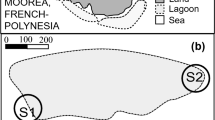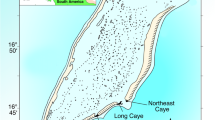Synopsis
Golden redhorse, Moxostoma erythrurum, and black redhorse, M. duquesnei, were observed spawning during the springs of 1984 through 1987 in Stony Creek, Illinois, at water temperatures ranging from 15–21°C. Both species spawned simultaneously within the same stream reach in 1987. Male golden redhorse aggressively defended territories on shoals and were joined by females from an adjacent pool. Black redhorse also spawned in riffles and displayed no agonistic behavior. Both species spawned throughout daylight hours in groups of two to five, and golden redhorse also spawned at night. Habitat utilization curves indicate that black redhorse spawned in habitat that was slightly deeper, much swifter, and over coarser substrate than that of the golden redhorse. Males of both species exhibited nuptial body color and breeding tubercles on anal and caudal fins, while only golden redhorse males had head tubercles. We suggest that these differences in spawning habitat, behavior, and morphology act as reproductive isolating mechanisms between the species and that the dichotomy in habitat and behavior may be due to competitive interactions.
Similar content being viewed by others
References cited
Bovee, K.D. 1986. Development and evaluation of habitat suitability criteria for use in the instream flow incremental methodology. Instream Flow Information Paper 21, U.S. Fish. Wildl. Serv. Biol. Rep. 86(7). 235 pp.
Bovee, K.D. & R.T. Milhous. 1978. Hydraulic simulation in instream flow studies: theory and technique. Instream Flow Information Paper 5, U.S. Fish. Wildl. Serv. FWS/OBS-78/33. 130 pp.
Bowman, M.L. 1970. Life history of the black redhorse, Moxostoma duquesnei, (Lesueur), in Missouri. Trans. Amer. Fish. Soc. 99: 546–559.
Breder, C.M., Jr. & D.E. Rosen. 1966. Modes of reproduction in fishes. Natural History Press, Garden City. 941 pp.
Buchanan, T.J. & W.P. Somers. 1969. Discharge measurements at gaging stations. U.S. Geol. Surv. Techniques Water-Resources Inv., Book 3, Chap. A8. 65 pp.
Burr, B.M. & M.A. Morris. 1977. Spawning behavior of the shorthead redhorse, Moxostoma macrolepidotum, in Big Rock Creek, Illinois. Trans. Amer. Fish. Soc. 106: 80–82.
Cross, F.B. 1967. Handbook of fishes of Kansas. Univ. Kans. Mus. Nat. Hist. Misc. Publ. 45. 357 pp.
Curry, K.D. & A. Spacie. 1984. Differential use of stream habitat by spawning catostomids. Amer. Midl. Nat. 11: 267–279.
Emlen, S.T. & L.W. Oring. 1977. Ecology, sexual selection, and the evolution of mating systems. Science 197: 215–223.
Hackney, P.A., G.R. Hooper & J.F. Webb. 1970. Spawning behavior, age and growth, and sport fishery for the silver redhorse, Moxostoma anisurum (Rafinesque), in the Flint River, Alabama. Alabama Department of Conservation, Game and Fish Division, Montgomery. 13 pp (mimeographed).
Hackney, P.A., W.M. Tatum & S.L. Spencer. 1968. Life history study of the river redhorse, Moxostoma carinatum (Cope), in the Cahaba River, Alabama, with notes on the management of the species as a sport fish. Proc. Southeast. Assoc. Game Fish Comm. 21: 324–332.
Horton, R.E. 1945. Erosional development of streams and their drainage basins; hydrophysical approach to quantitative morphology. Bull. Geol. Soc. Amer. 56: 275–370.
Hubbs, C.L. 1955. Hybridization between fish species in nature. System. Zool. 4: 1–20.
Hubbs, C.L. 1961. Isolating mechanisms in the speciation of fishes. pp. 5–23. In: W.F. Blair (ed.) Vertebrate Speciation, University of Texas Press, Austin.
Hubbs, C.L., L.C. Hubbs & R.E. Johnson. 1943. Hybridization in nature between species of catostomid fishes. Contrib. Lab. Vertebrate Biol., Univ. Mich. 22: 1–76.
Jenkins, R.E., 1970. Systematic studies of the catostomid fish tribe Moxostomatini. Ph. D. Dissertation, Cornell University, Ithaca. 799 pp.
Jenkins, R.E. & D.J. Jenkins. 1980. Reproductive behavior of the greater redhorse. Moxostoma valenciennesi, in the Thousand Islands Region. Can. Field-Nat. 94: 426–430.
Nelson, J.S. 1968. Hybridization and isolating mechanisms between Catostomus commersoni and C. macrocheilus (Pisces: Catostomidae). J. Fish. Res. Board Can. 25: 101–150.
Nelson, J.S. 1973. Occurrence of hybrids between longnose sucker (Catostomus catostomus) and white sucker (C. commersoni) in Upper Kananaskis Reservoir, Alberta. J. Fish. Res. Board Can. 30: 557–560.
Page, L.M. & C.E. Johnston. 1990. Spawning in the creek chubsucker, Erimyzon oblongus, with a review of spawning behavior in suckers (Catostomidae). Env. Biol. Fish. 27: 265–272.
Partridge, L. & P.H. Harvey. 1988. The ecological context of life history evolution. Science 241: 1449–1455.
Pflieger, W.L. 1975. The fishes of Missouri. Missouri Department of Conservation, Jefferson City. 343 pp.
Reighard, J. 1920. The breeding behavior of the suckers and minnows. I. The suckers. Biol. Bull. (Woods Hole) 38: 1–32.
Rivas, L.R. 1964. A reinterpretation of the concepts ‘sympatric’ and ‘allopatric’ with proposal of the additional terms ‘syntopic’ and ‘allotopic.’ System. Zool. 13: 42–43.
Schwartz, F.J. 1972. World literature to fish hybrids, with an analysis by family, species, and hybrid. Publ. Gulf Coast Res. Lab. Mus. 3, Ocean Springs. 328 pp.
Schwartz, F.J. 1981. World literature to fish hybrids with an analysis by family, species, and hybrid: supplement 1. NOAA Tech. Rep. NMFS SSRF-750. 507 pp.
Smith, C.G. 1977. The biology of three species of Moxostoma (Pisces: Catostomidae) in Clear Creek, Hocking and Fairfield counties, Ohio, with emphasis on the golden redhorse, M. erythrurum (Rafinesque). Ph. D. Dissertation, Ohio State University, Columbus, 158 pp.
Smith, G.R. 1966. Distribution and evolution of the North American catostomid fishes of the subgenus Pantosteus, genus Catostomus. Misc. Publ. Mus. Zool. Univ. Mich., No. 129. 132 pp.
Smith, P.W. 1979. The fishes of Illinois. University of Illinois Press, Urbana. 314 pp.
Smith, S.H. 1954. Method of producing plastic impressions of fish scales without using heat. Prog. Fish-Cult. 16: 75–78.
Stearns, S.C. 1984. The tension between adaptation and constraint in the evolution of reproductive patterns. Adv. Invert. Reprod. 3: 387–398.
Strahler, A.N. 1957. Quantitative analysis of watershed geomorphology. Trans. Amer. Geophys. Union 38: 913–920.
Author information
Authors and Affiliations
Rights and permissions
About this article
Cite this article
Kwak, T.J., Skelly, T.M. Spawning habitat, behavior, and morphology as isolating mechanisms of the golden redhorse, Moxostoma erythrurum, and the black redhorse, M. duquesnei, two syntopic fishes. Environ Biol Fish 34, 127–137 (1992). https://doi.org/10.1007/BF00002388
Received:
Accepted:
Issue Date:
DOI: https://doi.org/10.1007/BF00002388




